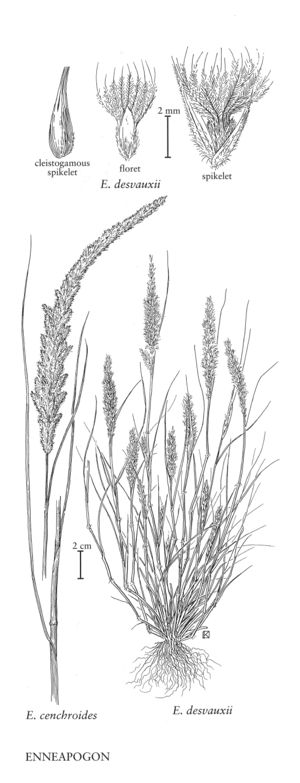Difference between revisions of "Enneapogon desvauxii"
FNA>Volume Importer |
imported>Volume Importer |
||
| (8 intermediate revisions by 2 users not shown) | |||
| Line 17: | Line 17: | ||
-->{{Treatment/Body | -->{{Treatment/Body | ||
|distribution=Md.;Colo.;N.Mex.;Tex.;Utah;Calif.;Pacific Islands (Hawaii);Okla.;Ariz.;Nev. | |distribution=Md.;Colo.;N.Mex.;Tex.;Utah;Calif.;Pacific Islands (Hawaii);Okla.;Ariz.;Nev. | ||
| − | |discussion=<p>Enneapogon desvauxii grows in open areas of the southwestern United States and in much of Mexico. It also grows in Peru, Bolivia, Argentina, and most of Africa, from which it extends eastward through Arabia and India to China.</p> | + | |discussion=<p><i>Enneapogon desvauxii</i> grows in open areas of the southwestern United States and in much of Mexico. It also grows in Peru, Bolivia, Argentina, and most of Africa, from which it extends eastward through Arabia and India to China.</p> |
|tables= | |tables= | ||
|references= | |references= | ||
| Line 26: | Line 26: | ||
-->{{#Taxon: | -->{{#Taxon: | ||
name=Enneapogon desvauxii | name=Enneapogon desvauxii | ||
| − | |||
|authority=P. Beauv. | |authority=P. Beauv. | ||
|rank=species | |rank=species | ||
| Line 33: | Line 32: | ||
|basionyms= | |basionyms= | ||
|family=Poaceae | |family=Poaceae | ||
| + | |illustrator=Linda A. Vorobik;Karen Klitz | ||
| + | |illustration copyright=Utah State University | ||
|distribution=Md.;Colo.;N.Mex.;Tex.;Utah;Calif.;Pacific Islands (Hawaii);Okla.;Ariz.;Nev. | |distribution=Md.;Colo.;N.Mex.;Tex.;Utah;Calif.;Pacific Islands (Hawaii);Okla.;Ariz.;Nev. | ||
|reference=None | |reference=None | ||
| Line 38: | Line 39: | ||
|publication year= | |publication year= | ||
|special status= | |special status= | ||
| − | |source xml=https:// | + | |source xml=https://bitbucket.org/aafc-mbb/fna-data-curation/src/200273ad09963decb8fc72550212de541d86569d/coarse_grained_fna_xml/V25/V25_937.xml |
|subfamily=Poaceae subfam. Chloridoideae | |subfamily=Poaceae subfam. Chloridoideae | ||
|tribe=Poaceae tribe Pappophoreae | |tribe=Poaceae tribe Pappophoreae | ||
Latest revision as of 17:59, 11 May 2021
Plants perennial. Culms 20-45 cm, about 1 mm thick, ascending to erect from a hard knotty base, often branching; nodes pubescent. Sheaths usually shorter than the internodes, more or less pubescent; ligules about 0.5 mm; blades mostly 2-12 cm long, 1-2 mm wide, more or less hairy, soon involute. Panicles 2-10 cm, spikelike, grayish-green or lead-colored. Spikelets mostly 5-7 mm, usually only the lowest floret bisexual. Glumes 3-5 mm, subequal, thin, puberulent; upper glumes often 3- or 4-veined; lowest lemmas 1.5-2 mm, firm, rounded on the back; awns 3-4 mm; anthers 0.3-0.5 mm. Caryopses 1-1.2 mm, oval, plump; embryos subequal to the caryopses. Cleistogamous spikelets commonly present in the lower sheaths, their lemmas larger than those of the florets in the aerial panicles, unawned or with awns that are much reduced. 2n = 20.
Distribution
Md., Colo., N.Mex., Tex., Utah, Calif., Pacific Islands (Hawaii), Okla., Ariz., Nev.
Discussion
Enneapogon desvauxii grows in open areas of the southwestern United States and in much of Mexico. It also grows in Peru, Bolivia, Argentina, and most of Africa, from which it extends eastward through Arabia and India to China.
Selected References
None.
